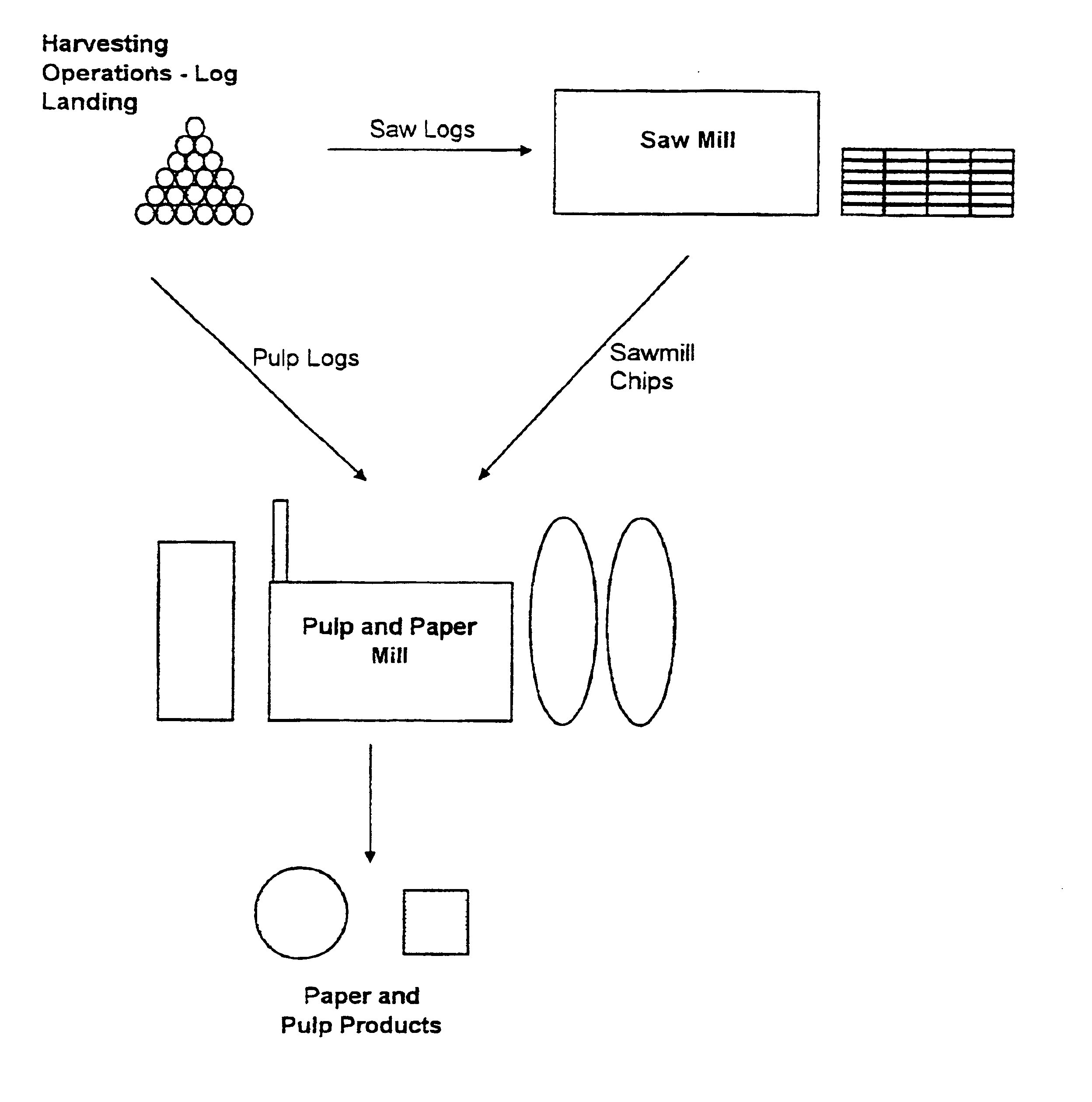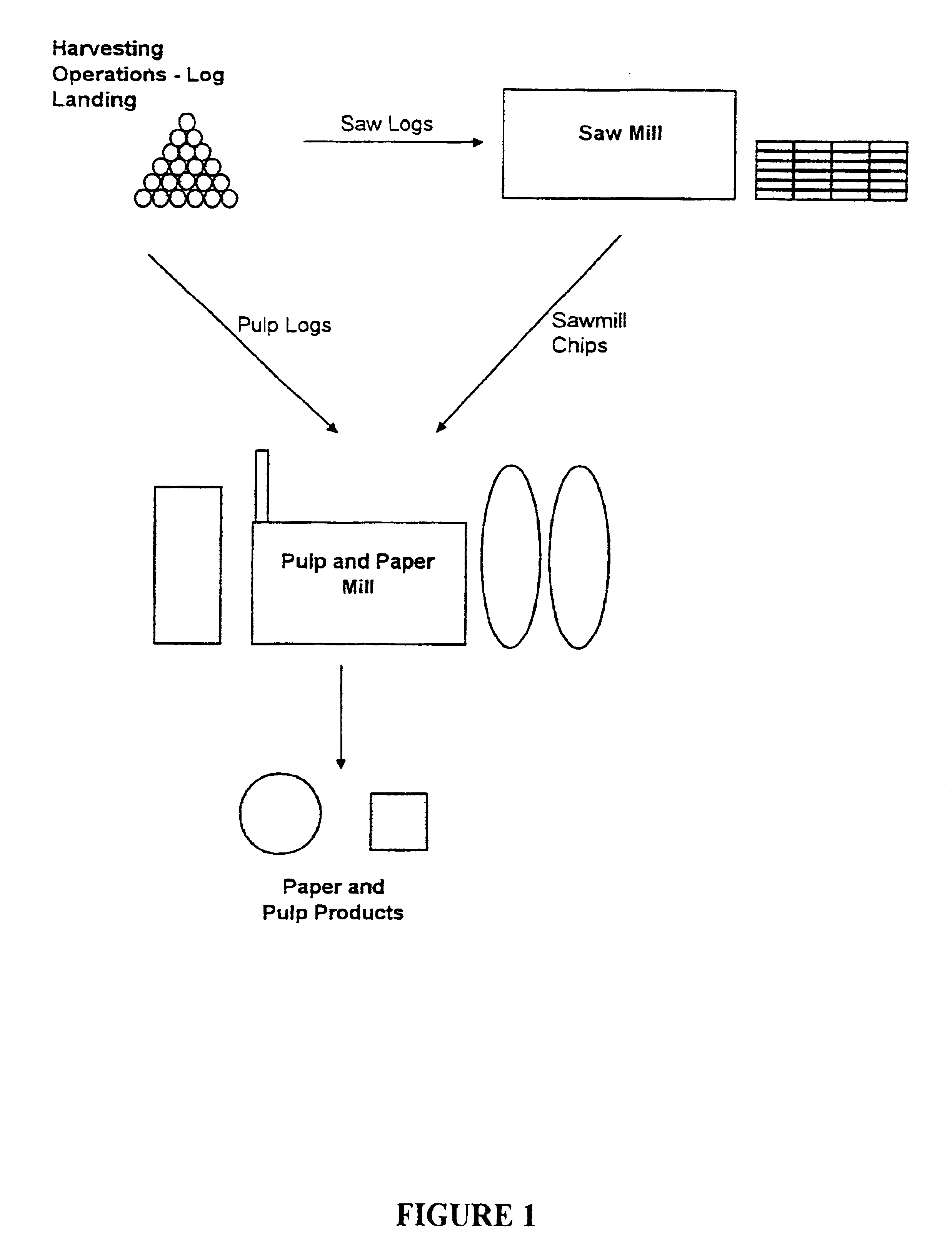Method of selecting and/or processing wood according to fibre characteristics
a technology of fibre characteristics and wood, applied in the direction of analysing solids using sonic/ultrasonic/infrasonic waves, processing detected response signals, material testing goods, etc., can solve the problem of complicated wood segregation issue, difficult to measure basic density, and little information on wood quality at individual stand level
- Summary
- Abstract
- Description
- Claims
- Application Information
AI Technical Summary
Problems solved by technology
Method used
Image
Examples
example 1
250 logs of radiata pine taken randomly from a lumber mill were peeled to expose the corewood at the centre of the log. Each peeler core was tested for speed of sound (using a Metriguard Model 239A stress wave timer), before samples from each log were taken for subsequent measurement of key pulp and paper properties.
The peeler cores, and their corresponding discs removed for pulping, were divided into classes with respect to sound speed. The sound speeds varied from 1.44 to 4.16.times.10.sup.3 m / s, and the population of peeler cores was divided into classes at 0.157.times.10.sup.3 m / s intervals, giving a total of 18 sound classes, each containing between 2 and 34 peeler core samples.
The samples for each sound speed class were grouped, chipped and pulped. The half scale Kappa number of each pulp was tested to ensure that it had been delignified sufficiently, and if so handsheets were formed for measurement of WZST strength, internal tearing resistance and tensile strength characteris...
example 2
250 logs of 12-42 cm large end diameter were tested for sound speed transmission (using Metriguard Model 239A stress wave timer). The logs were segregated into one of four groups based on sound speed:
Group 1: velocity<2.72 km / s
Group 2: 2.72.ltoreq.velocity<3.07 km / s
Group 3: 3.07.ltoreq.velocity<3.40 km / s
Group 4: velocity.gtoreq.3.40
The logs in each group were then chipped with a composite sample collected as the chips exited the chipping plant, so that four composite samples were collected, representative of the chips generated from each sound speed group.
Each chip sample was screened to remove oversized chips and fines and then kraft pulped under standard conditions (16% Effective Alkali, 30% Sulphidity, 1 hour time-to-temperature, 1 hour at 170.degree. C.) to approximately 26 kappa number. The pulps were washed and screened to remove shives, and then evaluated for properties.
LWFL was measured with a Kajaani FS200 fibre analyser. Pulps were refined in the PFI Mill for 1000 revoluti...
example 3
Eighty trees were felled from a 27 year old radiata pine plantation on the Mamaku Plateau in the Central North Island of New Zealand. Each stem was cut into four logs of 4.2 m length, yielding approximately 300 logs which were then tested for sound speed transmission using Metriguard Model 239A Stress Wave Timer. The logs were segregated into four groups according to their position within the stem. The range of sound speeds within each group were normally distributed with means and ranges as follows:
Within each log group, four sets of 5 logs were selected--the slowest 5 logs, 5 logs at the 33.sup.rd percentile of speed, 5 logs at the 66.sup.th percentile of speed, and the 5 fastest logs (the sub groups were designated I-IV respectively). Thus 20 individual logs were selected for each log group (Butt, Second, Third, and Top) giving 80 logs in total.
The logs were then cant-sawn into lumber according to a standard pattern, with the identification of each log tracked through the sawmill...
PUM
| Property | Measurement | Unit |
|---|---|---|
| frequencies | aaaaa | aaaaa |
| length | aaaaa | aaaaa |
| length | aaaaa | aaaaa |
Abstract
Description
Claims
Application Information
 Login to View More
Login to View More - R&D
- Intellectual Property
- Life Sciences
- Materials
- Tech Scout
- Unparalleled Data Quality
- Higher Quality Content
- 60% Fewer Hallucinations
Browse by: Latest US Patents, China's latest patents, Technical Efficacy Thesaurus, Application Domain, Technology Topic, Popular Technical Reports.
© 2025 PatSnap. All rights reserved.Legal|Privacy policy|Modern Slavery Act Transparency Statement|Sitemap|About US| Contact US: help@patsnap.com



